Description
The homeland of the Lanceleaf Lily variety (Lilium Lancifolium) is Japan and China. Gardeners began to cultivate this variety relatively recently - due to problems with poor survival rate, the wild-growing flower bloomed only in the 19th century. Thanks to intensive breeding work, scientists have managed to breed several hybrid varieties with an unpretentious character.
The so-called bulbous perennial - lily - reaches 2 meters in height. "Tiger" stems are stiff, moreover, they are tomentose-pubescent. The color is closer to purple. The bulb is white, large in size, has a spherical shape.
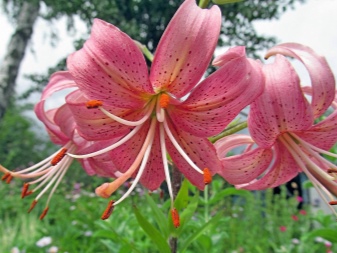
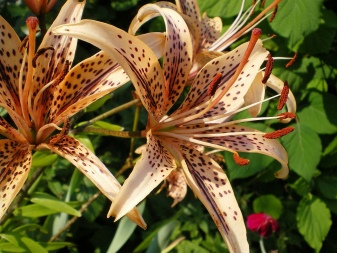
The lily family is distinguished by its root system, which consists of three types: bulbous basal, bulbous retractors and supra-luminal nourishing. The third type is formed above the bulb on the stem, looks like thin threads, performs the function of feeding and maintaining the stem in an upright position. The deciduous system is well developed - the leaves reach 15 cm in length, sessile, narrow, lanceolate, located on the stem alternately, painted mainly in dark green. In addition, the upper pair of leaves is much shorter, small bulbs are formed in their axils, intended for further propagation of the flower.

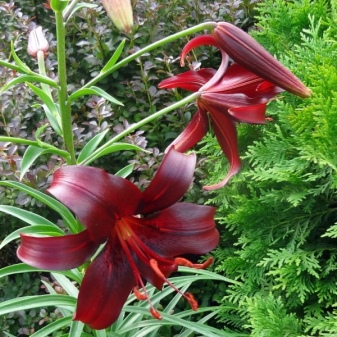
The lily inflorescences are lanceolate in structure, loose, racemose. They consist of large flowers (the number varies from 3 to 10), outwardly resembling bells. The length of the flowers is 10-12 cm, the pedicels are pubescent, the smell is weak. Blooming lilies have different colors - it all depends on the specific variety. In addition, the color on the buds lasts no more than a week.
So, a wild-growing lily has an orange color with noticeable specks on the inside of the bud. The flowering period is from July to September. The fruit is a capsule with many flat seeds. Interestingly, the first flowering occurs 3 years after the bulb is planted.
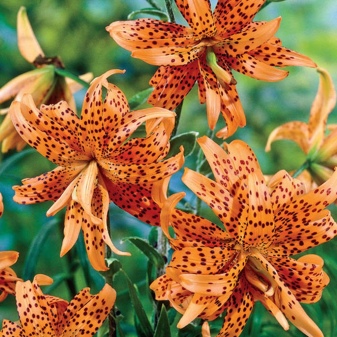
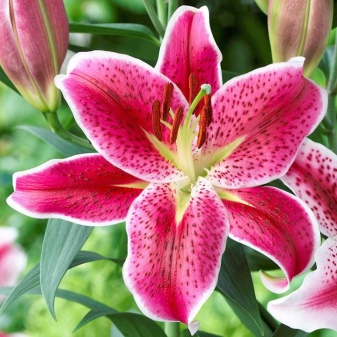
Reproduction methods
Lilies "Triumfator" can live on one site for about 4-5 years. An adult of this variety is usually characterized by a pair of nests of bulbs of different sizes and ages. Plants can be transplanted to a new location after the end of the flowering phase. The optimal period is September or October. Today, not only this method of culture propagation is known - there are other, no less effective methods.
- Foliage. During budding, leaves are plucked from the flowers, which are subsequently placed at an angle in a container with soil. In this case, the material is half-sprinkled with earth. After 40–45 days, the appearance of the bulbs can be observed.
- Using the stem. In the autumn or spring period after flowering, the stems must be separated from the bulbs and planted in a flower bed. If the planting material takes root, then bulbs will appear on it after about 45 days. To increase their number, the part of the stem that is in the ground needs to be cut longitudinally. In this case, the "Triumphant" blooms only by the second year of life.
- Scales. The bottoms of the bulbs, together with the scales, are planted in the soil. Irrigation of the soil is carried out exclusively when necessary. After about half a month, you can see the emergence of seedlings on the surface of the earth and bulbs under it.
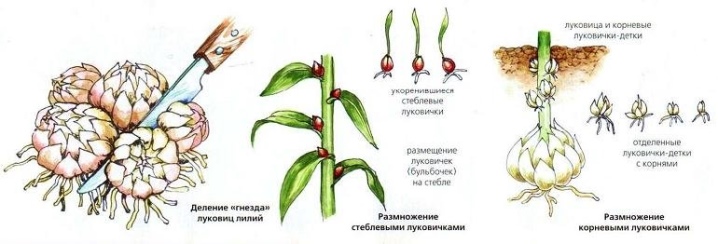
"Triumphant" is a gentle and capricious representative of the flora in terms of reproduction, so the technology must be correct. Reproducing this type of plant, it is worth waiting for the result with patience, without violating the necessary conditions.A negligent attitude to the procedure can lead to a lack of a positive result and decay of the planting material.
For more details on the breeding of the "Triumphant" lily, see the video.
Reproduction, planting and transplanting of bush lilies
There are several effective breeding methods. All of them are quite simple to perform and do not require much effort and supernatural knowledge:
The easiest and most commonly used is dividing the nest of the bulbs. After each season, daughter ones appear on the mother bulb. They also grow in size over time. Thus, the bulbs are pressed against each other and the process of flower growth is disrupted.
For normal development, lilies should be periodically separated from each other. This should be done after the end of flowering of the plant or before it, that is, in early spring or early autumn. Separated bulbs must be planted at the desired distance from each other. During the first year, young lilies need careful care, including feeding and watering. Full flowering can be achieved only after 2 years.

Lily propagation by dividing nests
Another way is to separate the daughter bulbs. They form on the underground part of the stem. They are separated only after the end of flowering, without removing the mother bulb from the ground. If this is not done, then the plant takes on the appearance of a bush and gradually loses its decorative effect.
After separation, the children are immediately transplanted into open ground to a depth of no more than 6 cm. When propagated in this way, the plant begins to bloom after 4 years. Early flowering is undesirable and can harm a young immature flower.
There is a way to get bulbs from scales. It is considered the most profitable method of flower propagation. Using it, you can get up to 120 new ones from one bulb. This procedure can be performed year-round, but flower growers still recommend doing this in early spring.
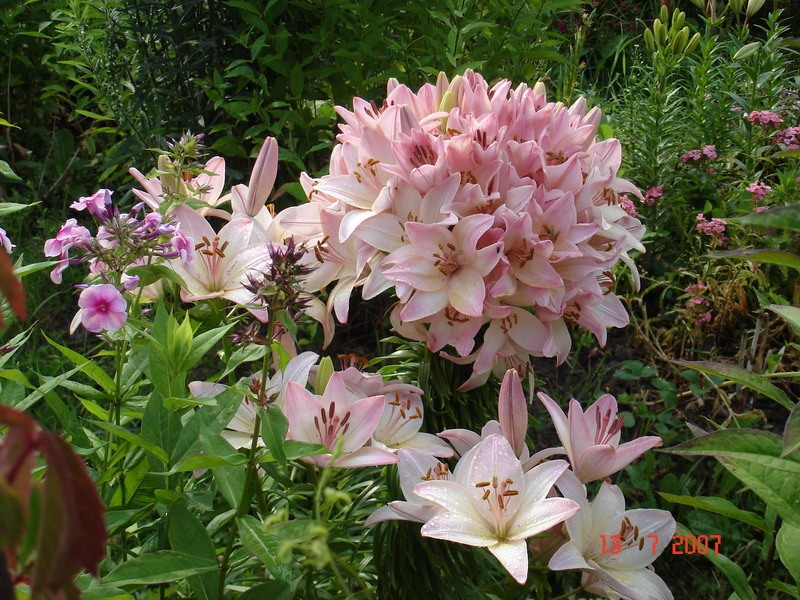
An experienced lily breeder is familiar with the concept of fasciation, which should definitely be considered. This state is a flattening and fusion of the stems of adult lilies, dividing at the top into several branches, giving mature buds.
The size of the flower in this case depends on the number of these same buds: the more there are, the smaller the diameter of the blossoming flower. The cause of this condition is still being studied. It is believed that this may be due to mechanical damage to the plant in the first stages of the growing season.
Planting and caring for the plant is also not difficult. It is necessary to carefully study the characteristics of the planting variety. Tall lilies should be planted in small groups or placed in the center of the flower bed. Low varieties will look great along the paths, at the very beginning of the flower garden. Planting period: early April - late September.
The most suitable depth for planting a bulb is one that is three times its size. The planted bulbs do not require special insulation and frost protection.
It is necessary to transplant adult bushes once every 3-4 years. The most suitable date for a transplant is the beginning of October. At this time, the plant is in a state of sleep.
Care
Pruning
The crown formation procedure is optional. But after flowering, wilted flowers remain on the plant, which must be removed on their own. Together with them, the ovary is cut off.
Seed bolls should not be allowed to appear
Seed propagation is used only by breeders. The bolls greatly deplete the plant, after which it will begin to ache. Therefore, at the beginning of autumn, when the leaves begin to fade, the flower growers cut off the branch with the ovary and the seed box. This plant is not suitable for composting. Therefore, it is recommended to burn the stems.
Landing
This representative of the flora does not grow well in calcareous soils. The soil must be slightly acidic or neutral, pH 5.9-6.7.
It is important that chernozem contains a large amount of vitamins and minerals. You can use purchased soil for home flowering lilies .. You can also prepare the substrate yourself
To do this, use sheet soil, turf, humus, peat. For air permeability, crushed charcoal is placed. Very small amounts of coarse sea sand are allowed. Drainage from pebbles, clay shards or natural stones is laid at the bottom of the pot. You can use granite, quarry, gravel or crushed stone
You can also prepare the substrate yourself. To do this, use sheet soil, turf, humus, peat. For air permeability, crushed charcoal is placed. Very small amounts of coarse sea sand are allowed. Drainage from pebbles, clay shards or natural stones is laid at the bottom of the pot. You can use granite, rubble, gravel or crushed stone.
The use of stones containing limestone is prohibited.
The containers should be 2-3 cm larger than the root system of the plant. Planting depth depends on the size.
Transfer
The transplant procedure should be carried out only in the spring.
If you transplant a flower during a cold period, then it will be very difficult for it to take root.
In one container, the plant is grown for 2-5 years.
The transplant is carried out as the pot is filled with the root system or from the speed of ripening of the daughter bulbs.
In both cases, the flower's nest must grow vigorously.
The fast-growing Asian Lily produces 2-3 daughter bulbs per year.
They must be removed from the mother plant.
At 5 years old, the soil of lilies is very depleted, which can lead to flower disease.
The pot material should be earthen or wood.
Do not use shavings, metal or plastic.
How to properly plant and transplant lilies is shown in the video below:
You can also explore other varieties of lilies: Water lily, Tiger lily, Marlene, Tacca Chantrieu lily, Oriental, Tubular, Henry lily, Amazonian and White lily.
Temperature
When grown in open ground, it is a frost-resistant plant. But it is necessary to use the mulching method. The layer of mulch must be at least 6 cm. It is allowed to use straw, forest moss, pine needles, tree bark.
When growing in indoor conditions, the plant must provide a temperature of 19-26 ° C in the summer. In winter, it is allowed to keep at a low temperature not lower than 12 ° C.
Lighting
The plant is very light-requiring. Asiatic Lilies need to provide bright natural light.
You cannot grow this representative of the flora in the shade.
In this case, the flower will begin to reach for the light, which will lead to a strong curvature and loss of decorativeness. The maximum curvature can be up to 45 °. In winter, when growing at home, the plant needs additional artificial lighting. Daylight hours should be at least 10-12 hours.
Description
This variety is a herbaceous perennial. In the wild, it grows in the forests of Eastern Siberia, as well as in the low-lying meadows of the Far East. The distinctive features of the plant include the following features:
- long ribbed stem of green or lilac shade, covered with fluff;
- large leaves of emerald color with a glossy sheen;
- erect inflorescences (diameter 10-12 cm), red-orange petals covered with small dark brown spots;
- the pistil is much longer than the stamens.


Daurian lily is also widespread in Mongolia, China and North Korea. The graceful perennial welcomes well-drained, fertile soil.
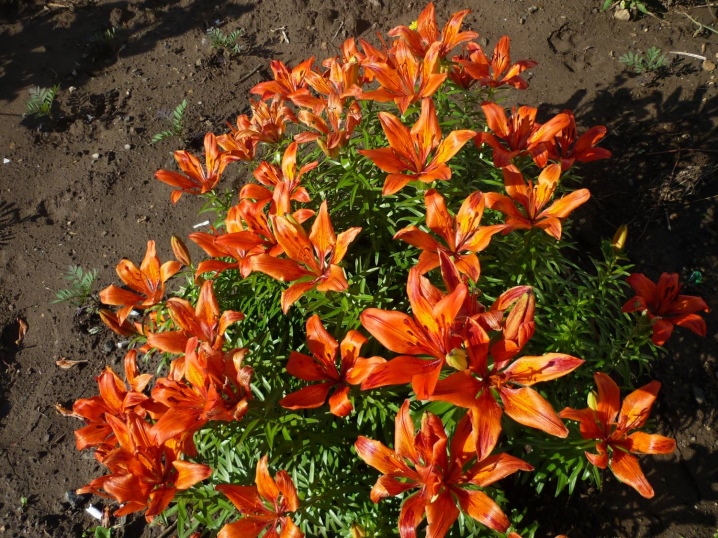
How to plant?
The most optimal season for planting LA hybrids lilies is spring and autumn. It is best to plant the plants in early April or the first half of October. It should be borne in mind that the most important condition for planting is compliance with the required temperature regime: the thermometer should not fall below + 15 ° C.It is this temperature regime that allows the plant bulb to take root well and take root in the soil. Moreover, the higher the air temperature, the more difficult and longer these processes will take place.
When choosing a suitable site, those that are well illuminated by the sun's rays should have an undeniable advantage. Ideally, the sun will illuminate the plant from early morning until lunchtime. If you plant a LA hybrid in a darkened place, the plant will lose its decorative properties, but will not die.
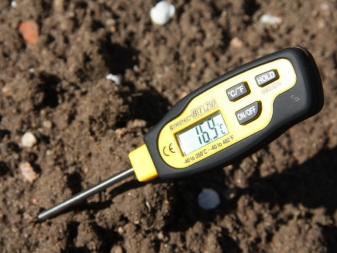
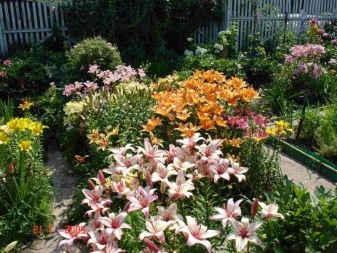
Before proceeding with the direct planting procedure, it is important to dig up the area where the lily will grow in the future. It should be borne in mind that the digging depth should be about 40 cm
Half of this depth will be needed for planting the plant, and the other half is needed to place the root system. And also it is necessary to take into account the quality of the soil: if it is rather heavy, then you need to add a small amount of sand to it. Moreover, it is allowed to use only washed river sand, and quarry clay material is prohibited. It is recommended to add sand in a ratio of 1 bucket per 1 m 2.


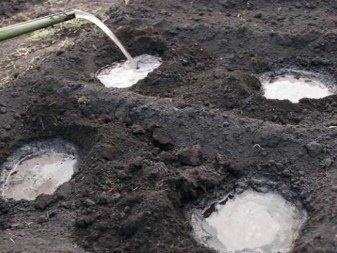

Features of growing Asian hybrids
Asian hybrids can be grown in one place without transplanting for 3-4 years. For 4-5 years, the height of the peduncle, the number of buds, is noticeably reduced, which means that the bulb is depleted and weakened, and this can lead to diseases and death of the plant. The formation of many short, underdeveloped stems around the main stem indicates a close arrangement of the formed bulbs, which means that it is time to dig up the nest of bulbs, carefully divide and plant in a new place. And in this place, you should not grow bulbous plants for two years.
Newly acquired bulbs should be transplanted to their permanent location as soon as possible. If this is not possible, then store them in a cool place at a temperature not lower than zero, wrapping them in moss, or in washed coarse sand, or in weathered peat. The lily bulb consists of fleshy scales without protective outer coverings, it does not have a dormant period, therefore it does not tolerate overdrying. If you got a dried onion, then you can restore its turgor by keeping it in wet sand or moss for several days before planting.
Before planting in a permanent place, damaged scales and old dried roots should be removed. In open ground, Asian hybrids are planted in early - mid September or in the spring at the end of April - May. The planting depth of the bulb depends on its size, and on the mechanical composition of the soil and is equal to 15-20 cm from the bottom to the soil surface. Asian hybrids are planted in a previously prepared fertile soil with a pH of 6-6.5, consisting of loam, peat, leaf humus and well-decomposed compost, bone meal and ash.
It is permissible to apply a complete mineral fertilizer with microelements. Sand is added under the bottom and around the bulb. Lilies, like all bulbous plants, do not tolerate the introduction of fresh organic matter and an abundance of nitrogen fertilizers. The soil is cultivated to a depth of 40 cm from the surface. Lilies do not tolerate stagnant moisture.
Asian hybrids are light-loving crops. Growing Asians in shade conditions is not recommended, as under these conditions the stems of the plants can bend at an angle of 45 ° C towards the light. A very important agricultural technique is mulching. The thickness of the mulch layer should be at least 5 cm. It can be pine bark, coniferous litter, straw, fallen tree leaves.
Top dressing is especially important during the period of bud formation and in the stage of their coloring. During flowering, fertilization should not be done, the abundance of nutrition leads to the rapid completion of flowering. The last top dressing with a predominance of potash fertilizers is needed to restore the bulb weakened by flowering and is carried out no later than August 15.
After flowering, wilted flowers should be removed along with the ovary, preventing the formation of seed pods.In September, when the leaves begin to turn yellow, the stem should be cut off at soil level. Dry cut stems are not suitable for composting and should be burned.
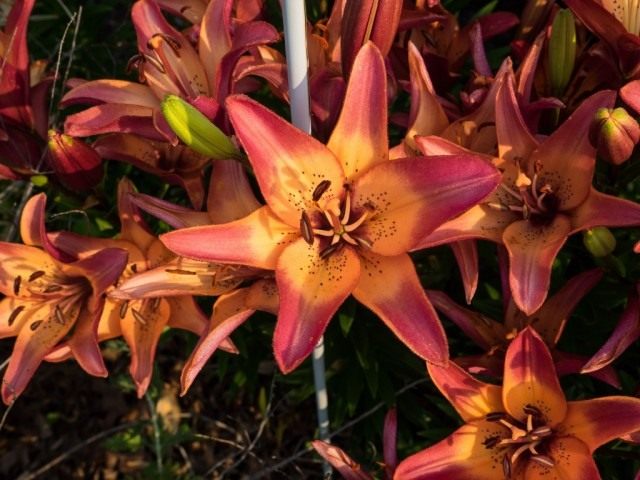 Lily 'Marquee'. F. D. Richards
Lily 'Marquee'. F. D. Richards


